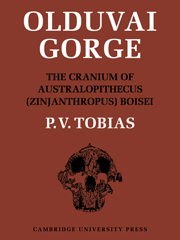Book contents
- Frontmatter
- Contents
- List of text-figures
- List of plates
- List of tables
- Introductory Note
- Foreword
- Editor's Note
- Acknowledgements
- I Introduction
- II Preservation and reconstruction of the cranium
- III The cranial vault
- IV The basis cranii externa
- V Certain critical angles and indices of the cranium
- VI The interior of the calvaria
- VII The thickness of the cranial bones
- VIII The endocranial cast of Zinjanthropus
- IX Metrical characters of the calvaria as a whole
- X The structure of the face
- XI The pneumatisation of the Zinjanthropus cranium
- XII The dental arcade and the palate
- XIII The pattern of dental attrition and occlusion, with comments on enamel hypoplasia
- XIV The size of individual teeth, absolute and relative
- XV The size of the dentition as a whole
- XVI The crown shape index of the teeth
- XVII The morphology of the teeth
- XVIII Summary of cranial and dental features of Zinjanthropus
- XIX The taxonomic status of Zinjanthropus and of the australopithecines in general
- XX The cultural and phylogenetic status of Australopithecus boisei and of the australopithecines in general
- References
- Index of persons
- Index of subjects
- Plate section
XIX - The taxonomic status of Zinjanthropus and of the australopithecines in general
Published online by Cambridge University Press: 05 November 2011
- Frontmatter
- Contents
- List of text-figures
- List of plates
- List of tables
- Introductory Note
- Foreword
- Editor's Note
- Acknowledgements
- I Introduction
- II Preservation and reconstruction of the cranium
- III The cranial vault
- IV The basis cranii externa
- V Certain critical angles and indices of the cranium
- VI The interior of the calvaria
- VII The thickness of the cranial bones
- VIII The endocranial cast of Zinjanthropus
- IX Metrical characters of the calvaria as a whole
- X The structure of the face
- XI The pneumatisation of the Zinjanthropus cranium
- XII The dental arcade and the palate
- XIII The pattern of dental attrition and occlusion, with comments on enamel hypoplasia
- XIV The size of individual teeth, absolute and relative
- XV The size of the dentition as a whole
- XVI The crown shape index of the teeth
- XVII The morphology of the teeth
- XVIII Summary of cranial and dental features of Zinjanthropus
- XIX The taxonomic status of Zinjanthropus and of the australopithecines in general
- XX The cultural and phylogenetic status of Australopithecus boisei and of the australopithecines in general
- References
- Index of persons
- Index of subjects
- Plate section
Summary
General considerations
‘Splitting’ and ‘lumping’: an historical perspective
The well-known trends of ‘splitting’ and ‘lumping’ are very much evident in the history of australopithecine taxonomy and nomenclature. Thus, at one time or another, the following generic labels have been applied to supposed members of this group: Australopithecus, Plesianthropus, Paranthropus, Telanthropus, Meganthropus, Praeanthropus, Zinjanthropus, and Hemanthropus (originally called Hemianthropus). We know today that many of these nomina did not represent valid taxa or good biological units.
By and large, splitting seems inevitable at an early stage in the sequence of discoveries of a group; lumping is equally inevitable at a later stage when many specimens have accumulated, when ranges of variation for the group in question and for related groups have been minutely explored, when the time dimension is better known, and when a deeper understanding has been gained of the functional and cultural capacities associated with a group of fossils showing a particular morphological pattern.
Because we now possess much of the detailed knowledge necessary to detect where affinities lie, the time is ripe for a reconsideration of hominid fossil designations and the combining of previously separated groups of fossils into broader and more valid taxa.
The fact that the author has been led by his studies of Zinjanthropus and other australopithecines to regard them all as members of a single genus is based not upon any enhanced biological insight, but upon the irresistible body of evidence that has accumulated over the four decades since Australopithecus africanus was named and launched by Dart (1925).
Information
- Type
- Chapter
- Information
- Olduvai Gorge , pp. 219 - 235Publisher: Cambridge University PressPrint publication year: 1967
